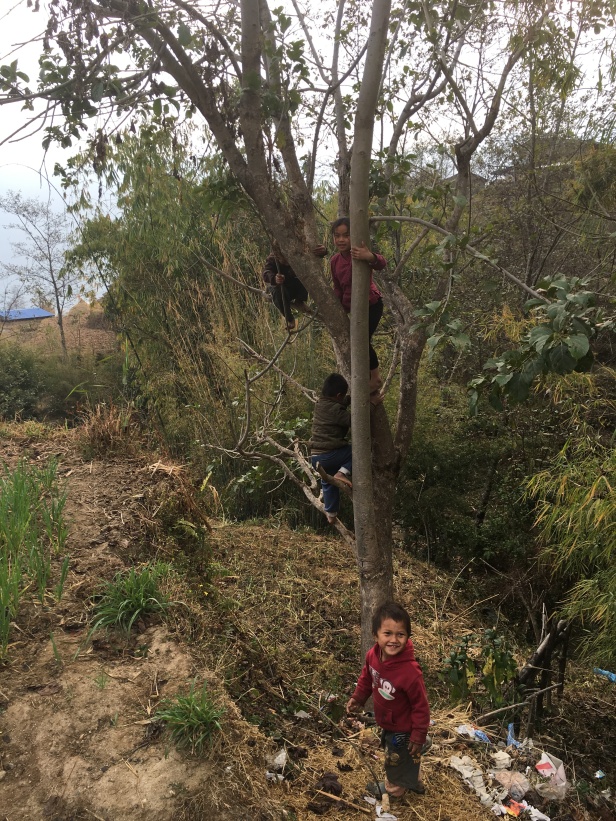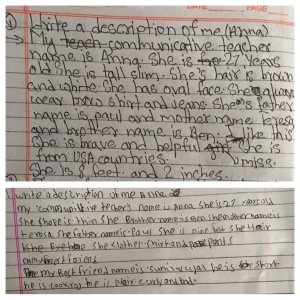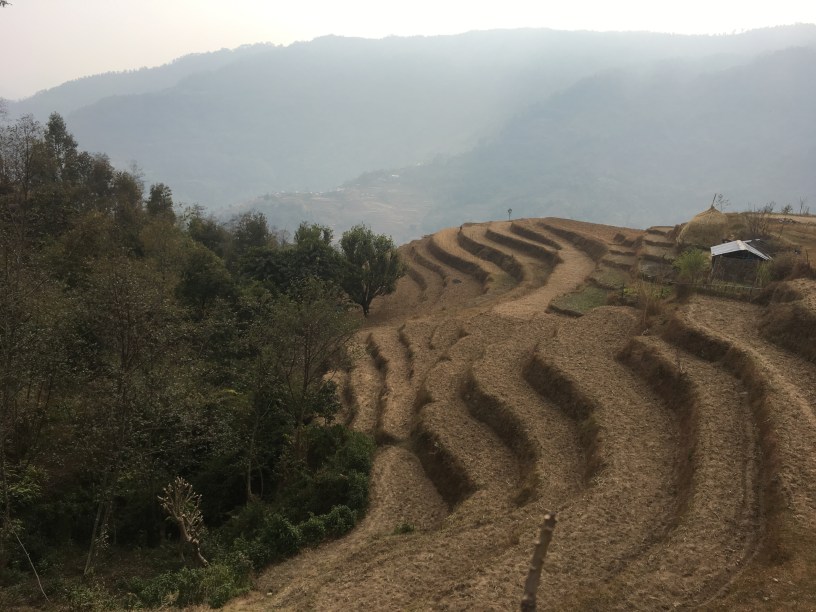





I had a bit of trouble formatting this one from the mobile account, but I want to get this out there for all of you! I’ll keep learning about this blogging stuff…
I arrived in Bhomechowk after a six hour microbus ride followed by a five hour cramped jeep ride on an incredibly dusty, rough road through the foothills of the Himalayas, deep into the Lamjung district. Along the way we went through small villages and up and over a ridge with beautiful (if hazy) mountain views. We arrived right around sunset and headed straight to where I’d be staying for the next three weeks.
The home that I stayed in was a very comfortable but not superfluous. Seating was on woven mats on the floor, and there was a earthen stove in the back corner where Aama (mother) created all the wonderful dalbaht I would eat for the three weeks. The doorways and ceiling was low, and I had a habit of hitting my head at least once everyday. My room was part of an addition on the side of the house – a long, narrow room, just large enough for two single beds end to end and a dresser. The bed was covered with a woven mat and a quilt and covered with a big fluffy comforter. I shared this room with Didi, my Nepali sister, who was close to my age. The electricity was available in the evenings and mornings, so there was no trouble charging electronics.
It was very comfortable, except that a hive of honey bees lived in the side of the house above my room. Occasionally they would crawl through the gap between the roof of my room and the side of the house. One stung my finger the first night I was there, and I stepped on one a few days before I left. The stings smarted, but the itching was worse. It would show up a day after the sting and lasts nearly two weeks! My toe still itches now, if I bump it on something. Himalayan honeybees are no joke!
My close family consisted of Dai (brother) Om, Didi (sister), and Aama (mother). Aama was a funny, beautiful woman who was always listening to the radio and trying to feed me – just like my mother back home. She wore traditional garb, a friendly grin, and the marks of a life of hard work and sunshine. Didi knew occasional words in English, and was very fun. She enjoyed laughing at me in a friendly way and sometimes could help me understand what was happening around me. Om was an excellent resource for my many questions, and I really enjoyed and learned so much from our conversations. He has so many plans for his home, school, and village, and is such a hard worker, I’m sure that he will make them happen. He spoke with such pride about his village and all that they have accomplished, but was very humble about his role in all of it. Four children lived next door, and they provided lots of entertainment for me. Once I found them up in a tree on my way home from school. Fitting, as they could be real monkeys in class.
Days usually started slowly. At 5:05 (exactly) every morning, a rooster would crow on the other side of the wall from me. I would usually read some and slowly wake up, getting cleaned up finally before tea and a snack around 7:00am with my family. As time went on, I got to do one chore to help out – I would fill up the jugs of drinking water and bringing them back from the community tap every morning, a short walk up the hill.
After tea I would go for walks in the neighborhood. It was my time to have a little bit of time to myself (other than all of the villagers that I would see, who would watch, keeping watch of my whereabouts) and enjoy the beauty of the morning light in the mountains. I would then return and take a little bit of time making sure my lessons and materials were in order for school.
Aama would serve us tasty dalbaht every day before we would head off to school. School in Bhomechowk started at 10:15 and I taught 6/7 classes in a day. I spent a lot of time with the younger students (k-5) but also visited the older classes. Sometimes I would team teach with their regular teacher, but often I had the classes to myself. If I was tired, I could have taught less, but working with the students was my favorite part of the day. I was very glad that school was six days a week, rather than five days like back home, because I loved working with the students and teachers so much.
At first the students were a little shy, and I didn’t really know where to start, as I didn’t know how their school worked and I didn’t know what English they already knew. Everything was a little overwhelming at first, as I wasn’t really sure if they were learning anything or not. After the first week, their shyness disappeared, and their lovable naughtiness came out. I tried many different types of activities to find out what would work for each class (and what definitely didn’t work). It was so interesting which activities they really engaged with and which they definitely did not. Each class was different.
Sometimes the younger children would be working, and then suddenly would switch into crazy mode, running around on the tables and rolling around on the floor putting each other in headlocks! Once, this happened when we were learning verbs. I quickly learned that the verb ‘to fly’ was a trigger, and I did my best not to say it again in class! As I am not one to use the cane on children, which is the norm there (a cultural difference), I would redirect them by pulling out drawing paper.
Like magic, they would sit down and start drawing quietly, and then would label their drawings in English. Small strips of paper that they would write sentences on and put in a hat worked really well for another. Stickers were another great incentive, and they would do a lot of work for a sticker. Class 1 had to take an exaggerated calming breath (with arm motions) before re-entering the class after leaving to use the toilet, rather than cruising in as little packets of energy. By the third week, I had a pretty good idea what worked for each class, and was sad to be leaving. Even with the occasional chaos, they were just so excited all of the time, it was impossible to get mad at them.
The class that struck a happy medium for my was class 5. They were so good natured in their goofiness and were happy to try most of my activities. One of my favorites was having them write a description of me (their textbook activity was all about describing people). I’ll include a couple here for you to enjoy! On my one free period, they had leisure time, and absolutely loved games, so I taught them a few of my most fun ones. Never before have I met a group of children who were so excited to play a simple game for hours on end. Watching them run while doubled over in laughter filled me with so much joy! Afterwards I’d frequently find rhododendron tucked into my folder.
After school we would have tea and a snack back at home with Aama. Then I would spend some time writing in my journal and playing with the neighbor children until dinner time (more tasty dalbaht) after dinner I’d talk about all sorts of topics with Om until everyone was tired and it was time to sleep.
Days that we didn’t have school were filled with a lot of reading for me. One day I got to help with spreading manure and carrying some firewood, which everyone found very amusing. Other than that, as a guest, it was hard to get them to let me help them with any work. ‘Basnus!’ I heard a lot (Please sit!). A highlight of one day off was when Om took me trekking all around Lamjung, which i’ll write about in another post!
I also got to witness a memorial program for a recently deceased uncle. This was a five day program with lots of dancing, food, and praying to appease the spirit and send it off. This was such an incredible experience, I will write a blog post specifically about it. I felt so honored to be a part of it, as I know most people visiting Nepal don’t get to experience this part of the culture. I only wish I could have been a happy occasion!
In all, my time in Lamjung was incredible. I didn’t have any access to my phone or internet, so I was forced to really be present. The warmth and openness of the people who let me into their homes and their lives was truly remarkable. It was incredibly challenging too. My Nepali language skills are very limited, and the people speak their own complete language anyways (not Nepali), so communication was a challenge. Often, especially the first week, I was confused: Where are we going? When is dalbaht happening? When am I supposed to leave after being invited into someone’s home for tea? What am I supposed to do in this social situation? There were so many questions I wish I could have asked some of the villagers, especially the elderly. I feel like they had so much wisdom to give, but I didn’t have the tools to receive it, so I always felt I was missing out! I think this was also why I gravitated toward the children – language doesn’t matter so much, children are children, and they are happy to play with you even if you can’t talk much to them.
Despite all of the challenges, there was so much communication that happened without words. The smiles and laughs from the villagers assured me I was a welcome member of their community. I learned so much and I look forward to returning to my Nepali family to visit!

This was difficult to read as misty eyed with pride I am! So happy about your sharing your Self with the fabulous people of Nepal.
LikeLike
Beautiful! I think I would have gotten along well with Aama.
LikeLike